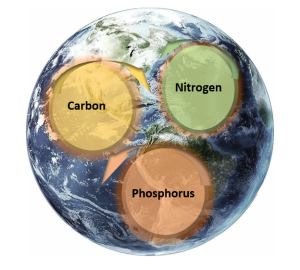Module 7: Biogeochemical Cycles
Section outline
-

Biochemical cycles refer to the processes through which essential elements are circulated among all living organisms on Earth. Once common elements move through the atmosphere, lithosphere, and biosphere, they can take on various chemical forms. Six elements are consistently recycled in organic molecules, namely: carbon, hydrogen, nitrogen, oxygen, phosphorus, and sulfur. These elements play a vital role in sustaining life on Earth. For instance, carbon is a key element that forms the backbone of organic macromolecules. Nitrogen, on the other hand, is a critical component of nucleic acids such as DNA and RNA and is important for agriculture. Phosphorus is a key constituent in the backbone of the DNA and RNA structures. Hydrogen and oxygen can be found in water as it changes forms as a liquid, vapor, or ice. Lastly, sulfur is the main constituent of protein and is also released through different layers of the ecosystem. The picture shows how carbon, nitrogen, and phosphorus nutrients are in a continuous cycle on the planet Earth. (Image: Waneene C. Dorsey, Grambling State University).
Upon completion of this module, you will be able to:
- Explain what nutrients are and give examples.
- Discuss the concept of nutrient cycling and describe important compartments and fluxes.
- Describe factors that affect the development of major soil types.
- Describe the cycles of carbon, nitrogen, phosphorus, and sulfur.
To achieve these objectives:- Read the Module 7 Introduction
- Read Chapter 7 in Pressbooks.
- Complete the Chapter 7 Focused Reading Quiz.
- Complete the assignment and discussion questions.
-
Guidelines for how to import content into Moodle
-
This document shows the Chapter 7 PowerPoint Presentation slides.
Background Colour
Font Face
Font Kerning
Font Size
Image Visibility
Letter Spacing
Line Height
Link Highlight
Text Colour
